![]()
![]()
![]()
Use LEFT and RIGHT arrow keys to navigate between flashcards;
Use UP and DOWN arrow keys to flip the card;
H to show hint;
A reads text to speech;
39 Cards in this Set
- Front
- Back
- 3rd side (hint)
|
Capillaries |
Intricate network of thin hair like vessels connecting arteries and veins. Blood vessels. |
|
|
|
Microscope |
In the early 1600'S this technological device was invented. Used lenses to zoom in on a speciemen. Enlarges an image till we can see clear and defined cells and other small specien |
Zoom zoom |
|
|
Compound microscope |
Any microscope that has two or more lenses |
|
|
|
Light must __________ the thin specimen for us to see it clearly |
Travel through |
|
|
|
How should you prepare your work area before bringing a microscope tp it? |
Make sure there is no water/fluids/food matter on the area and clear the work area |
|
|
|
How should you carry the microscope? |
One hand on the arm and one hand underneath |
|
|
|
What position should you always keep your microscope? |
Upright |
|
|
|
What parts of the microscope should you keep clean? |
All of the lenses and glass for a clearer image |
|
|
|
Eyepeice |
Contains the lenses that magnifies |
|
|
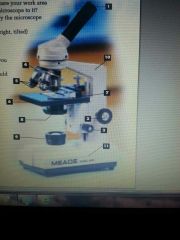
1-11? |
1. Eyepiece 2. Coarse adjustment knob 3. Fine adjustment knob 4. Revolving nose piece 5. Objective lenses 6. Stage 7. Stage clips 8. Diaphragm 9. Lamp 10. Arm 11. Base |
|
|
|
Coarse adjustment knob |
Moves the stage up or down to focus on thr object to produce a clear sharp image |
|
|
|
Fine adjustment knob |
Brings the object into sharper focus |
|
|
|
Revolving nose piece |
Holds the 3 objective lenses |
|
|
|
Objective lense |
Provide different strengths of power of magnification |
|
|
|
Stage |
Supports the slide that holds the object you want to view |
|
|
|
Stage clips |
Holds the slide firmly on the stage |
|
|
|
Diaphragm |
Has different sized holes that let in different amounts of lights pass through the object you're viewing |
|
|
|
Lamp |
Supplies the light that passes through the object you're viewing |
|
|
|
Arm |
Allows you to carry the microscope securely |
|
|
|
Base |
Serves as a foundation for the rest of the microscope |
|
|
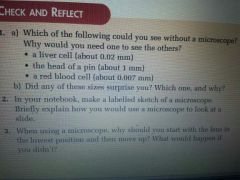
|
1. The head of a pin 2. Put the slide on the stage 3. To have a clearer image |
|
|
|
2. 2 |
The cell is the basic unit of life |
|
|
|
Cells |
An individual unit of life |
|
|
|
Tissue |
A group of specializes cells |
|
|
|
Organ |
A group of tissues that perform a specific funtion |
|
|
|
Organ system |
A group of organs |
|
|
|
What are 3 factors that affect how you clearly you see the parts of the cell |
1. Type of microscope 2. Power of the lenses 3. Quality of the prepared slide |
|
|
|
What are the steps for preparing a wet mount slide |
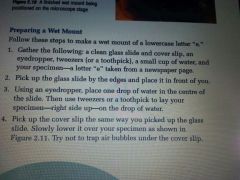
|
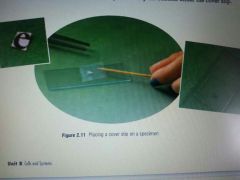
Water |
|
|
Organelles |
Specialized structures within each cell |
|
|
|
Nucleus |
A command center that directs all the cellular activities such ad movement growth and other life functions |
|
|
|
Mitochondria |
The powerhouse of the cell where chemical reactions occur that convert the energy the cells receives into something the cell can use |
|
|
|
Cell membrane |
A controllable that lets needed materials in and waste materials out |
|
|
|
Vacuoles |
The storage where nutrients water or other substances can be stored by the cell. Plant cells have one large acuoles and animal cells have many small ones |
Cupboard |
|
|
Cytoplasm |
The kitchen of the cell. It contains the nutrients required by the cell to maintain its life process |
|
|
|
Cell wall |
The frame of the cell. Found in plant cells not animal cells. It provides strength and support to plants |
|
|
|
Chloroplasts |
The solar panels in the green parts of plant cells. Carry out photosynthesis |
|
|
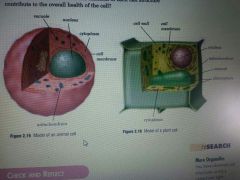
Which one is a plant cell? 1st one or 2nd? |
Second |
|
|
|
2. 3 |
Organisms can be single celled or multi celled |
|
|
|
Bg |
Gb |
|

